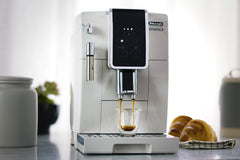
We all have our own cleaning routines for our coffee equipment to remove leftover grounds, stubborn residue, and coffee bean oils… the list goes on.
But when was the last time you cleaned the inside of your electric kettle?
When it comes down to it, the kettle is something that just completely slips most of our minds during our regular cleaning routine. Some of us assume that regularly being exposed to boiling hot water cleans the walls enough.
However, left unattended, electric kettles can experience issues over time, and it’s important that you take a look inside on a regular basis to identify any mineral deposits or stains of rust.
Here’s a short guide on what causes this and how to effectively clean them away.
What Causes Rust in Kettles?
The best way to resolve an issue is to understand its cause.
Electric kettles tend to be made from high-quality steel, while their heating elements usually combine nichrome, nickel, and chromium.
Rust generally forms when acidic substances (such as water) come into contact with these metals. It is the result of the steel corroding due to its iron particles coming into contact with oxygen and moisture.
As you can imagine, electric kettles create the perfect environment for rust stains to form.
Why Is It Important to Remove Rust?
Of course, it’s relatively common sense that you should avoid consuming food or beverages that have been in contact with rust. Our bodies naturally produce iron, the main component of rust, and many of us do actively try to incorporate more iron into our diets.
But there are healthier and more convenient ways to do this, such as a healthy, balanced diet and supplements. Rust in an electric kettle will contaminate the taste and texture of your drinks and can leave a nasty taste in your mouth.
Excessive, regular consumption of rust could also result in health issues that are better avoided.
How to Remove Rust Spots
So, if you have rust spots in your kettle, what do you need to do in order to remove them? Here are some tips that will help with this.
Note: It's important to never use abrasive cleaners or steel wool on the inside of the kettle as they can scratch the surface and make it more prone to rusting.
Use White Vinegar
White vinegar is one of the most useful, natural cleaning ingredients. Not only can it promote shine and eliminate odor, but it’s great for removing rust from the inside of your kettle too.
-
Fill the kettle with equal parts water and white vinegar. Make sure the kettle is at least half full.
-
Let the mixture sit in the kettle for at least an hour. You can let it sit for longer if the rust build-up is particularly stubborn.
-
After an hour or longer, dump out the vinegar-water mixture and rinse the kettle thoroughly with clean water.
-
If there is still some stubborn stains remaining, you can make a paste of baking soda and water and apply it to the rusted areas with a soft cloth.
-
Let the paste sit on the rust for at least 30 minutes, then rinse the kettle thoroughly with clean water.
-
Once the rust is removed, run the kettle with clean water a few times to make sure there is no vinegar or baking soda residue left behind.
-
Finally, wipe the kettle dry with a clean, damp cloth and it should be good to use again.
Use Lemon Juice
Lemon has many uses besides its delicious flavor. In fact, it can be used as a cleaning agent that is perfect for use in your kettle.
It offers a less harsh alternative to vinegar solution, so is a better cleaning solution for use on kettles with smaller patches of rust build-up.
-
Squeeze the juice of one or two lemons into the kettle. Use enough lemon juice to cover the rusted areas.
-
Fill the kettle with water until the rusted areas are completely submerged.
-
Bring the water and lemon juice mixture to a boil and let it boil for 15-20 minutes.
-
Turn off the heat and let the mixture cool down.
-
Once the mixture is cool enough to handle, pour it out and use a soft sponge or cloth to wipe away the rust.
-
Rinse the kettle thoroughly with clean water to remove any lemon residue.
-
Finally, wipe the kettle dry with a clean cloth, and it should be good to use again.
Note: Lemon juice contains citric acid, which can help break down rust and limescale buildup. However, it's important to not leave the lemon juice mixture in the kettle for too long as it can damage the interior.
Use Kettle Cleaning Products
Of course, rusty kettles are common, and where there’s demand, the market will provide a solution.
This means that there are now many kettle cleaning products that have been specially formulated to tackle rust stains in a way that won’t damage your kettle itself.
Shop around to find an option that looks good and fits within your budget. Then, make sure to follow the instructions on the packet for the best results.
Preventing Future Creation of Rust
If your kettle hasn’t yet developed any rust formation, or if you’ve managed to remove rust from your kettle, you can take steps to prevent rust from developing in the future.
Keep Your Kettle Dry
The key is to prevent water from stagnating in the kettle. This means keeping it as dry as possible for the majority of the time.
Ideally, you should only have water inside your kettle when it is being used. As soon as you have poured your drink, it’s best to pour the remaining water out and allow your kettle to air dry (it’s generally best to leave the top open to allow this) to prevent a prolonged damp environment.
Alternatively, if your kettle has a large enough opening, you can dry off the inside with a microfiber cloth.
Daily Cleaning
Daily cleaning can help to prevent buildup of rust too. Simply fill your kettle with a mixture of warm water and mild dishwashing soap. Give it a swirl, empty the soapy water and rinse thoroughly.
Then, of course, leave to air dry or dry using a soft, clean cloth.
Rust is a common issue that you are likely to experience at some point when owning and regularly using an electric kettle. The good news is that it is easily resolved.
Hopefully, some of our advice will help you remove even clumsy rust spots from your kettle and prevent them from developing again.






